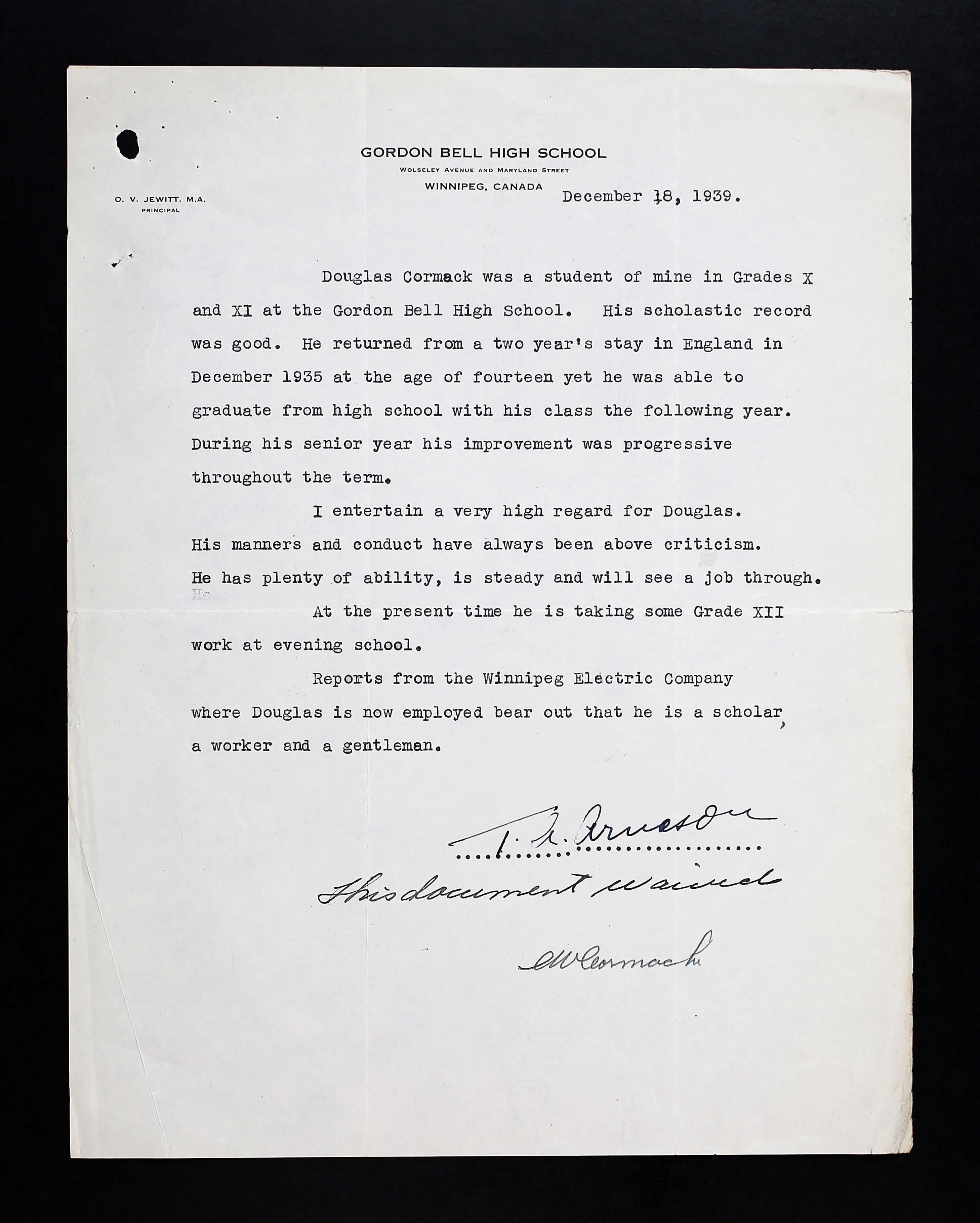
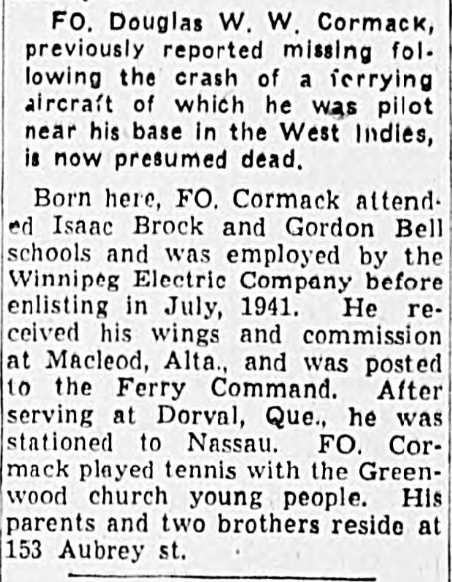
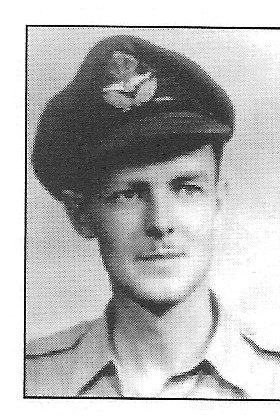
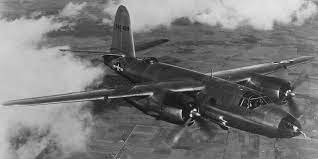
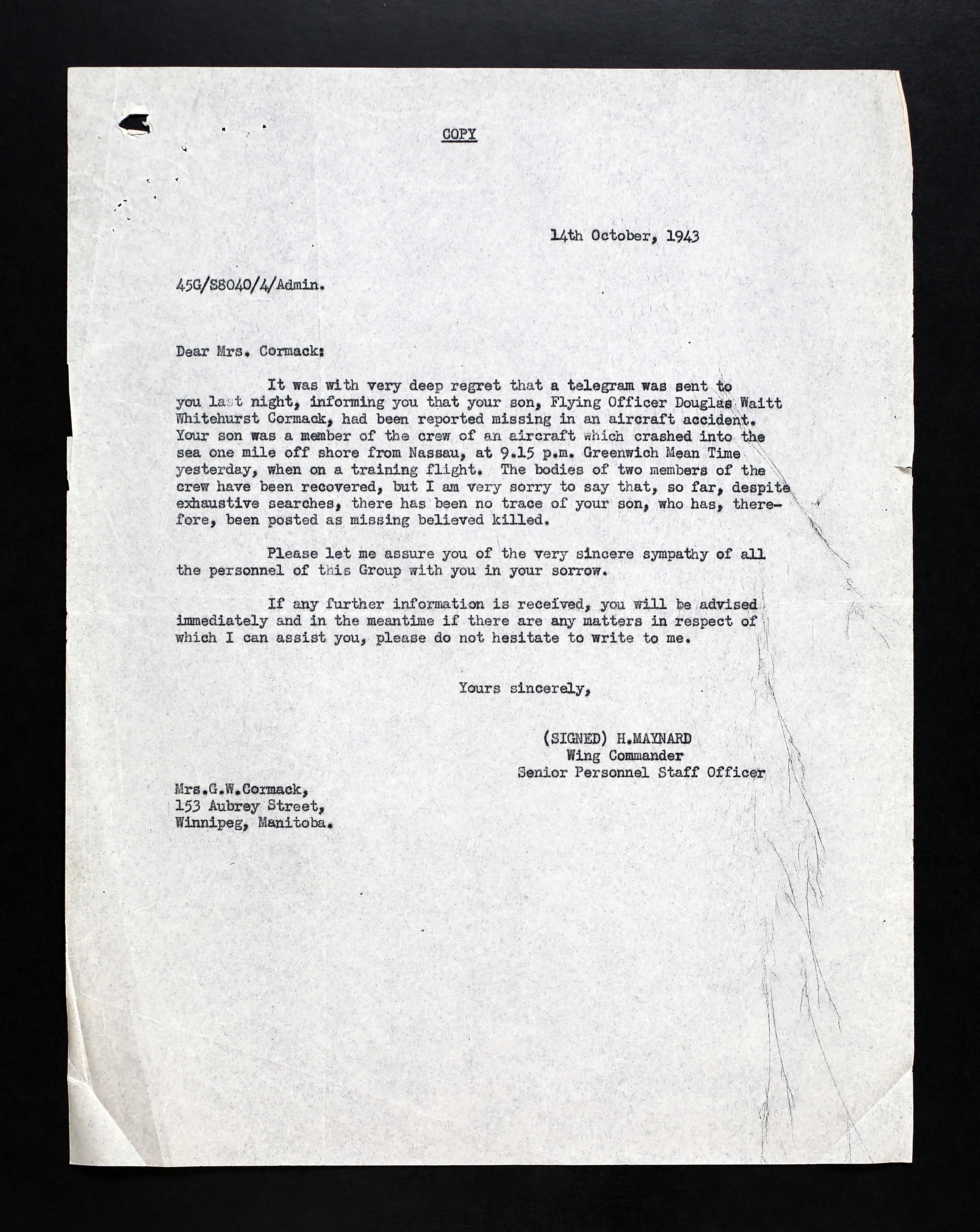
December 12, 1921 - October 13, 1943





Douglas Waitt Whitehurst Cormack was the son of George Waitt Cormack (1896-1952) and Lillian (nee Whitehurst) Cormack (1896-1955) of Winnipeg, Manitoba. He had two brothers, Jack (1920-2010) and Gordon. The family attended the United Church. Mr. Cormack served with the RAF during WWI and with the RCAF during WWII. Douglas lived in England for two years in 1935.
Douglas first enlisted with the NPAM in May 1941 for about five weeks. He had tried to enlist with the RCAF in December 1939 and again in February 1941. “History very good. This is a keen and eager candidate, however physically he is slight, small boned and poorly developed. He only weighs 105 at present. Eyes unfit for pilot or aircrew. Holds bread 50 only. This is a very eager, good-looking candidate. Alert, cooperative, intelligent. His body build is slight. Age 19. Would suggest exercise (body and eyes) and careful recheck later. His spirit is excellent but physical make-up is not likely to stand up against the strain of modern aircraft. He is most anxious to make air crew standards.” Later, he weighed 118 pounds and stood 5’ 6 ½” tall. He had blue eyes and brown hair, with a sallow complexion.
He was working as a messenger in 1938, then a mail clerk, office clerk, then clerk all for the Winnipeg Electric Co. Ltd. He liked to skate, play tennis, and build models. At some point, he fractured 4-5 fingers, but no disability. “Very good response to all tests. Candidate is small and underweight but wiry and shows good muscle development.” Other comments: “Tests satisfactory but candidate too light on 26 pounds. underweight, therefore unfit on this account at present.” By October 3, 1941: “Good average pilot material. Fit. Keen.” After the war, he hoped to remain in the RCAF.
His journey through the BCATP began at No. 2 Manning Depot, Brandon, Manitoba on June 28 until August 1941. He found himself at No. 15 SFTS, Claresholm, Alberta until September 25, 1941. From there, Douglas was in Edmonton at No. 4 ITS from September 26 to November 22, 1941. “22nd out of 125 in class. 89%. Alert. Ambitious. Very keen, energetic type. Plays tennis well. Good appearance. Good personality. Father RFC overseas last war. RCAF at present Winnipeg Wireless School.”
He was next in High River at No. 5 EFTS from November 23, 1941 to January 31, 1942. “Good average pilot. Will improve with time. GROUND TRAINING Above average. Bright, cheerful, clean cut, courteous, dependable. Conduct very good. Link 80%.” He was 20th in his class with a 76.4%.
Douglas then was at No. 7 SFTS Macleod, Alberta until June 20, 1942, where he earned his wings. “An average pilot, steady progress, resourceful, slightly weak on instruments. GROUND TRAINING: Showed good effort throughout. ARMAMENT: Wind speed and direction finding: average. Straight funs over as pilot: below average.” GENERAL REMARKS: Distinguished pass. An above average student worked hard in Ground School and took a keen interest in flying.” He was 10th in his class with a 75.5%.
He was sent to No. 31 O.T.U. Debert, Nova Scotia June 21, 1942, until assigned to RAF Ferry Command July 1, 1942. Douglas was part of RAF Ferry Command, based out of Montreal, Quebec and was captain of a Hudson. By May 16, 1943, he was based out of Nassau, Bahamas.
He was sending home $40/month in partial support of his parents. He had $500 in his Bank of Toronto account as of May 13, 1943, plus additional funds at the Bank of Nassau in the Bahamas, plus held a life insurance policy.
Mrs. Cormack received a letter dated October 14, 1943, from W/C H. Maynard, Senior Personnel Staff Officer. “It was with very deep regret that a telegram was sent to you last night, informing you that your son had been reported missing in an aircraft accident. Your son was a member of the crew of an aircraft which crashed into the sea one mile offshore from Nassau, at 9:15 PM yesterday went on a training flight. The bodies of two members of the crew have been recovered, but I am very sorry to say that, so far, despite exhaustive searches, there has been no trace of your son, who has, therefore, been posted as missing believed killed. Please let me assure you of the very sincere sympathy of all the personnel of this group with you in your sorrow…” From other sources, one of the plane’s engines caught fire before it crashed into the sea.
Other men aboard Marauder II FB454 were Flying Officer Roland Henry Barber, pilot, RAF, Flying Officer Denis Durward, RAF, and Flight Lieutenant John Griffith Owen, RAF. Durward’s name is also on the Ottawa Memorial. Barber and Owen were buried at the Nassau War Cemetery.